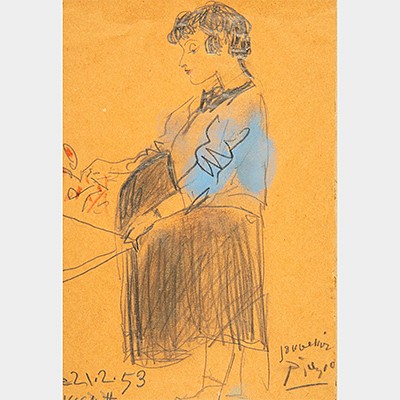ANDY WARHOL (Pittsburgh, USA, 1928 - New York, USA, 1987). "Lillian Carter, 1977. Graphite on paper. Signed on the back.
Lot 79
About Seller
Setdart Auction House
Carrer Aragó 346
Barcelona
Spain
Setdart Subastas was born in 2004 and is currently the first online art auction in Spain with solidity, prestige and reliability guaranteed by our more than 60,000 users. Setdart has a young, dynamic and enterprising team ready to successfully manage the purchase and sale of art works through custom...Read more
Categories
Estimate:
EUR€30,000 - EUR€35,000
$32,608.70 - $38,043.48
Absentee vs Live bid
Two ways to bid:
- Leave a max absentee bid and the platform will bid on your behalf up to your maximum bid during the live auction.
- Bid live during the auction and your bids will be submitted real-time to the auctioneer.
Bid Increments
| Price | Bid Increment |
|---|---|
| EUR€0 | EUR€10 |
| EUR€200 | EUR€25 |
| EUR€500 | EUR€50 |
| EUR€1,000 | EUR€100 |
| EUR€3,000 | EUR€200 |
| EUR€5,000 | EUR€500 |
| EUR€10,000 | EUR€1,000 |
| EUR€20,000 | EUR€2,000 |
| EUR€50,000 | EUR€5,000 |
About Auction
By Setdart Auction House
Sep 20, 2021
Set Reminder
2021-09-20 08:00:00
2021-09-20 08:00:00
America/New_York
Bidsquare
Bidsquare : CONTEMPORARY ART
https://www.bidsquare.com/auctions/setdart-auction-house/contemporary-art-7482
Setdart Auction House sofia@setdart.com
Setdart Auction House sofia@setdart.com
- Lot Description
ANDY WARHOL (Pittsburgh, USA, 1928 - New York, USA, 1987). "Lillian Carter, 1977. Graphite on paper. Signed on the back. Provenance: Christie's: American Pastimes-Sports & Politics. This work originates from the Estate of Andy Warhol, and from there, the Andy Warhol Foundation for the Visual Arts. Christie's will maintain a database of this work which will be used to corroborate provenance in the future to provide relevant information for the Andy Wahol Raissoné Catalogue. Attached is a certificate of authenticity issued by The Andy Warhol Foundation for the Visual Arts. Measurements: 103.8 x 51.4 cm; 125 x 92 cm (frame). Warhol was fascinated by the ambiguous border between politics and the concept of fame. As a result, he contributed his own interpretation of the subject by blending the two seemingly not so disparate worlds. He projected and inflected the idea of celebrity in his portraits, including those of politicians such as Lillian Carter's son, Jimmy Carter, President of the United States, as well as herself. American visual artist who became the best known representative of Pop Art, an artistic trend in vogue during the 1950s and 1960s that was inspired by mass culture. The son of Slovak immigrants, he began his art studies at the Carnegie Institute of Technology between 1945 and 1949. In the latter year he began his career as an advertising cartoonist for various magazines such as Vogue, Harper's Bazaar, Seventeen and The New Yorker. At the same time he painted canvases with everyday, advertising and comic themes. He soon began to exhibit in various galleries. He progressively eliminated any expressionist traits from his work until he reduced it to a serial repetition of a popular element from mass culture, the world of consumerism or the media. This evolution reached its peak of depersonalisation in 1962, when he began to use a mechanical silkscreen printing process as his working method, by means of which he systematically reproduced myths of contemporary society, the most representative examples of which are the series dedicated to Marilyn Monroe, Elvis Presley, Elizabeth Taylor and Mao Tse-tung, as well as his famous treatment of Campbell's soup cans, all works produced during the fruitful decade of the 1960s. The use of mass-circulated images, easily recognisable to all kinds of audiences, such as the aforementioned soup cans or Coca-Cola bottles, became one of the most interesting and stable features of his entire output. On other occasions he crudely depicted real situations, such as accidents, street fights, funerals or suicides; within this theme, Electric chair is one of his most significant works. This appropriationism, a constant feature of the work of the supporters of Pop Art, extended to universal works of art by authors such as Raphael Sanzio, Giorgio de Chirico, Edvard Munch and Leonardo da Vinci. Through mass reproduction, he succeeded in stripping the media fetishes he used of their usual referents, turning them into stereotypical icons with a decorative meaning. In 1963 he set up the Factory, a workshop in which he brought together numerous figures from New York's underground culture. The frivolity and extravagance that marked his way of life established a coherent line between his work and his life's trajectory; his peculiar appearance, androgynous and permanently topped with a characteristic blond fringe, ended up defining a new icon: the artist himself. He was one of the first creators to consciously exploit his image for self-promotional purposes; through a process of identification, he acquired in the eyes of the public the significance of just another advertising product. In 1963 he began a film career based on the same principles as his plastic work (such as visual reiteration), sometimes with a strong sexual and erotic content.
- Shipping Info
-
In-house shipping available. Please inquire at admin@setdart.com.
-
- Buyer's Premium



 EUR
EUR CAD
CAD AUD
AUD GBP
GBP MXN
MXN HKD
HKD CNY
CNY MYR
MYR SEK
SEK SGD
SGD CHF
CHF THB
THB













